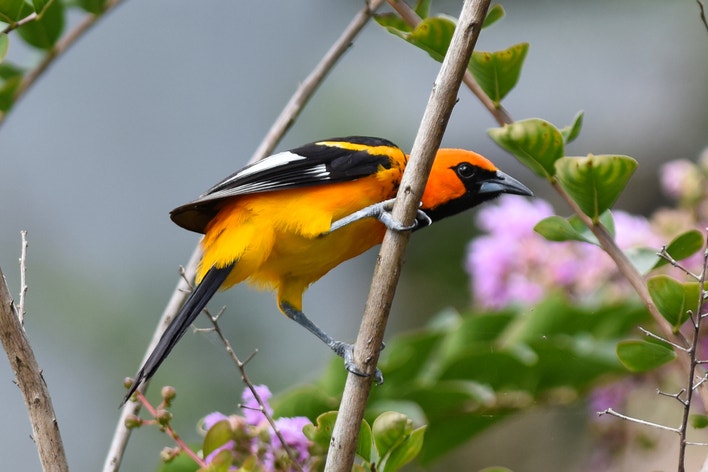Spot-breasted Oriole
At a Glance
Native to southwestern Mexico and Central America and sometimes kept as a cagebird, this large oriole apparently escaped from captivity in the Miami area in the late 1940s. The suburbs of southern Florida, with their gardens of exotic plants, provided a suitable habitat for some tropical birds, so the Spot-breasted Oriole thrived there. Its numbers have been hurt occasionally by exceptionally cold winters, but it is currently doing well in some areas between Miami and West Palm Beach.
All bird guide text and rangemaps adapted from Lives of North American Birds by Kenn Kaufman© 1996, used by permission of Houghton Mifflin Harcourt Publishing Company. All rights reserved.
Category
Blackbirds and Orioles, Perching Birds
IUCN Status
Least Concern
Habitat
Forests and Woodlands, Urban and Suburban Habitats
Region
Florida
Behavior
Direct Flight, Rapid Wingbeats
Range & Identification
Migration & Range Maps
Apparently a permanent resident throughout its tropical range, and introduced population in Florida is resident also.
Description
8" (20 cm). Only Florida oriole with bright orange head and black throat. Spots on sides of chest; much white in black wings. Immature duller, may lack spots. Juvenile all dull yellow at first.
Size
About the size of a Sparrow, About the size of a Robin
Color
Black, Orange, Red, White
Wing Shape
Rounded
Tail Shape
Rounded, Square-tipped
Songs and Calls
Like that of other orioles-loud, varied, and continuous.
Call Pattern
Falling, Flat, Undulating
Call Type
Buzz, Chatter, Chirp/Chip, Whistle
Habitat
Tall trees, suburbs. In our area, found only in suburbs of southern Florida, in neighborhoods with many exotic trees and shrubs bewaring berries and flowers at all seasons. In native range in the tropics, found mostly in dry woods, thorn scrub, trees along rivers, trees in towns.
Sign up for Audubon's newsletter to learn more about birds like the Spot-breasted Oriole
Behavior
Eggs
Probably about 2-5. Whitish to pale blue, marked with brown and black. Incubation is probably by female, but incubation behavior and timing are not well known.
Young
Both parents bring food to the nestlings. Age at which the young leave the nest is not well known. Young may stay with parents for some time after fledging.
Feeding Behavior
Forages mostly by moving rather slowly and deliberately among branches and foliage of trees. Often visits flowers; may use its bill to break off long blossoms to get at nectar at the base.
Diet
Includes berries, nectar, insects. Diet has not been studied in detail, but includes many berries and small fruits, also some cultivated fruit. Takes nectar from flowers, and may eat parts of the flowers as well. Also eats many insects.
Nesting
In spring, male sings rich, whistled song to defend nesting territory; female may sing at times also. Nest: Placed in tree, near end of slender branch and often well above ground (in the tropics, may also nest in yuccas or other low plants). Nest (apparently built by female) is long hanging pouch, woven of grass, palm fibers, and other plant fibers, with its rim firmly attached to branch and the rest hanging free.
Conservation
Conservation Status
Seems not to have competed seriously with any native birds in our area. Numbers in Florida declined sharply after cold winters in late 1970s and early 1980s, but have partly recovered.
Climate Threats Facing the Spot-breasted Oriole
Choose a temperature scenario below to see which threats will affect this species as warming increases. The same climate change-driven threats that put birds at risk will affect other wildlife and people, too.




